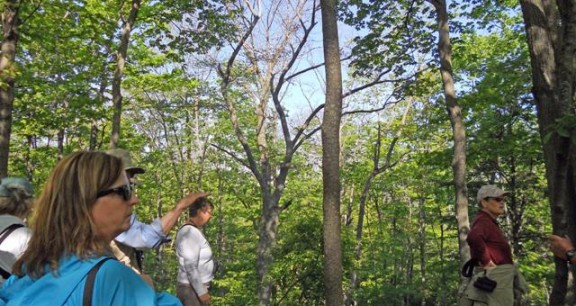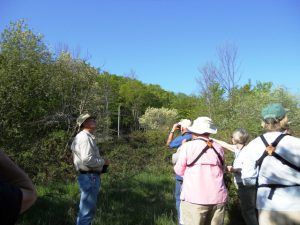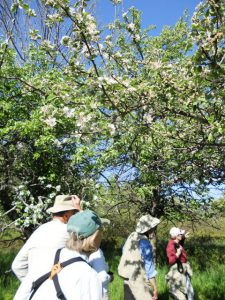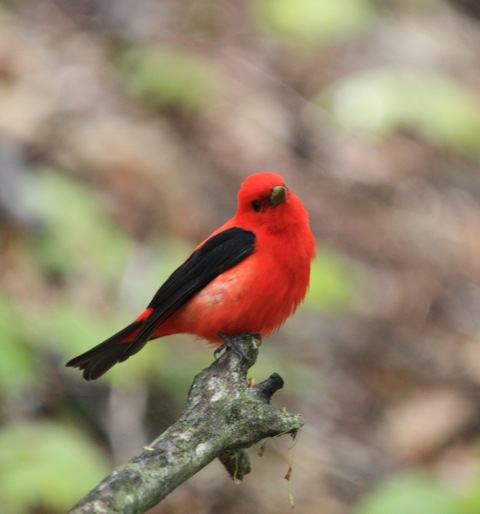Wildflowers, Warblers, Water and Wonder!

May 19, 2012–Kay Charter claims not to be a bird expert. Now, I don’t claim to be a bird expert either, but she’s definitely a lot closer to claiming that title than I ever will be. Kay, who works with Saving Birds Thru Habitat, makes her skills apparent before we even leave the parking lot at Lighthouse West Natural Area; she casually picks up different bird songs around her like it’s instinctual; a Scarlet Tanager there, a Gray Catbird over there. She gives a little background on the area, which used to be old fields from a dairy and sheep farm, and we head off on a winding trail surrounded by tall grass and wildflowers.

The group has about 15 people, both young and old, all with a pair of binoculars slung around their necks and enthusiasm in their faces. We don’t get too far down the trail before a huge tree offers us several Cowbirds, Cedar Waxwings and Eastern Wood Pewees. People point and chat excitedly, steering others to the best specimens. “The key is no big, sudden movements,” Kay says, “talking is fine, they just don’t like a lot of commotion.” This lends itself to a very social, yet still educational experience.
A couple of Bluebirds fly overhead as we make our way towards some old knobby apple trees. A tiny Least Flycatcher pokes out from among the apple blossoms, its comically large eyes and beak becoming a point of conversation. It seems that every step offers a new bird species to observe. In fact, so many different species congregate at Lighthouse West for a very specific reason. Neotropical migrant birds from South and Central America make their way north for the summer to find cooler climates. They put off flying over bodies of water like the Great Lakes for as long as possible, funneling instead into areas like Lighthouse West, which is located just north of Northport. The habitats of these peninsulas become very important places for these migrating songbirds and also offer a large variety of species. At the end of our outing we counted 32 different species of birds, amazingly.
One of the main stars of the morning was a Common Yellowthroat, a small warbler spotted in a black cherry tree. The tiny bird was throwing its head back and singing its little heart out—it was like it was putting on a performance for all the lucky birders that morning. You could see his distinctive, brilliant yellow chest and black bandit eye-coloring. He is soon upstaged though by the songs of the Catbird, whose pretty songs mixed with the sounds of crickets around us.
 We make our way past hummingbirds, swallows, and Rose-breasted Grosbeaks. Two small warblers are spotted—the mustard-colored Palm Warbler and the shockingly yellow Nashville Warbler. The Palm Warbler is known for its characteristic tail-pumping and nest-stealing reputation. As I was told, the Palm Warblers used to move around with Buffalo for food purposes, making it difficult to establish a new nest with such migratory habits. They evolved a system where they take over existing nests of other birds and convert it into their own, saving time and work. Who knew such little birds could be so crafty?
We make our way past hummingbirds, swallows, and Rose-breasted Grosbeaks. Two small warblers are spotted—the mustard-colored Palm Warbler and the shockingly yellow Nashville Warbler. The Palm Warbler is known for its characteristic tail-pumping and nest-stealing reputation. As I was told, the Palm Warblers used to move around with Buffalo for food purposes, making it difficult to establish a new nest with such migratory habits. They evolved a system where they take over existing nests of other birds and convert it into their own, saving time and work. Who knew such little birds could be so crafty?
Another star of the show was definitely the Scarlet Tanager, which is known for its fiery red plumage. One sits in the upper branches of a tree, looking “just like a Christmas ornament,” one hiker remarks. An Indigo Bunting flits past, its bright blue wings shimmering in the sun. Eventually we enter the bluff region of the natural area and are greeted by the cool shade of the maple trees. A Black and White Warbler makes an appearance (for some) before going back into hiding in the canopy to join the Red-eyed Vireo spotted earlier. After nearly 2 hours we arrive back at our cars safe and sound, although I will say that an encounter with a rogue milk snake was harrowing. All in all, the snake was a small price to pay for a perfect day of birding.
–Taylor Jolliffe, Outreach Intern 2012




